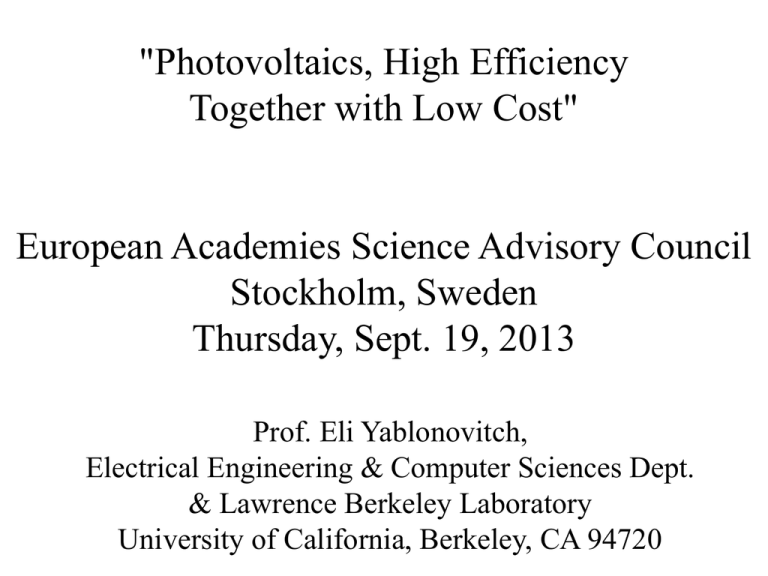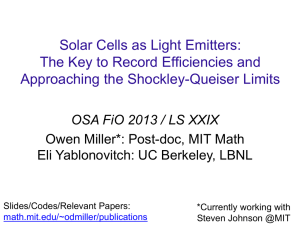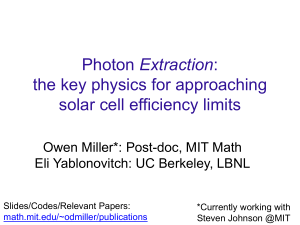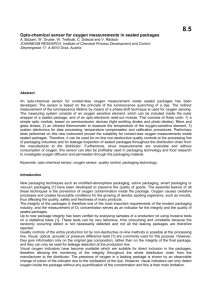Eli Yablonovitch: Photovoltaics, high efficiency together
advertisement

"Photovoltaics, High Efficiency
Together with Low Cost"
European Academies Science Advisory Council
Stockholm, Sweden
Thursday, Sept. 19, 2013
Prof. Eli Yablonovitch,
Electrical Engineering & Computer Sciences Dept.
& Lawrence Berkeley Laboratory
University of California, Berkeley, CA 94720
30
Efficiency (%)
29
28
27
Alta Devices record, 28.8%
1-sun, single junction,
solar cell efficiency record:
26
25
24
1990
1995
2000
2005
Year
2010
Open Circuit voltage VOC (Volts)
1.15
Alta Devices record cell, 1.122 volts
1.10
1.05
Open Circuit voltage for
record efficiency cells:
1.00
0.95
1990
1995
2000
2005
Year
2010
efficiency %
new
physics
33.5%
normal solar cells
~25%
0%
Shockley-Queisser
limit (single-junction)
high performing cells
h
h
h
h
h
e-
25.1%
efficiency
1990-2007
h
28.8%
efficiency
2011-2012
h+
hg
e
h+
hg
Efficiency vs. Rear Reflectivity,
33.
5
GaAs 3m
90%
Rear
Reflectivity
Is Not
Enough!
Cell Efficiency
(%)
33.2%
32.
5
32.2%
31.9%
31.
5
30.
5 0
0.2
0.4
0.6
0.8
1
Reflectivity
32.6
1.14
5
1.115
1.104
1.14
1.12
1.10
32.4
32.2
1.08
1.06
0
32.50
32.46
32.43
Jsc
(mA/cm2)
Voc (Volts)
1.16
32
0.2
0.4
0.6
Reflectivity
0.8
1
0
0.2
0.4
0.6
0.8
Reflectivity
1
Latest 1 sun
single-junction
results from
Alta Devices, Inc.
Expected to reach
34% dual junction,
eventually.
h
h
h
h
h
e-
25.1%
efficiency
1990-2007
h
28.8%
efficiency
2011-2012
h+
hg
e
h+
hg
What if the material is not ideal, and the electrons and
holes are lost to heat before they can luminesce?
qVoc = qVoc-ideal – kT|ln{ext}|
Only external
Luminescence can balance
the incoming radiation.
The external
fluorescence yield ext
is what matters!
Paradox: Why is external luminescence is good for
solar cell efficiency?
Reason #4; Luminescence IS Voltage:
External luminescence is sometimes used as a type of
contactless voltmeter, indicating the separation of
quasi-Fermi levels in the solar material.
At quasi-equilibrium:
Luminescence = (Black Body) exp{qV/kT}
(This is sometimes employed as a contactless, qualitycontrol-metric, in solar cell manufacturing plants. )
This viewpoint is tautological:
Good external luminescence actually is good voltage, and
therefore good efficiency.
Objections to: “Good luminescence IS good voltage”
1. My solar cell doesn’t luminesce at all!
answer: Undoubtedly the voltage is very low,
but there is always some small luminescence.
2. I need to separate the electron and hole as quickly as possible.
There is little time for radiative recombination.
e-
answer: That built-in electric field is costing
voltage, which means less luminescence.
V
h+
3. I need to suppress fluorescence occurring before the
electron and hole have separated, which would cost current.
answer: The suppressed fluorescence is an indicator that
voltage was sacrificed for current.
The carrier extraction needs improvement.
For solar cells at 25%,
good electron-hole transport is already a given.
Further improvements of efficiency above 25% are
all about the photon management!
A good solar cell has to be a good LED!
Counter-intuitively, the solar cell performs best when
there is
maximum external fluorescence yield ext.
Miller et al, IEEE J. Photovoltaics, vol. 2, pp. 303-311 (2012)
GaAs solar cells are the preferred technology,
where cost is no objection: Space
The Epitaxial Liftoff Process:
GaAs
Courtesy of
Alta Devices,
Inc.
Dual Junction Series-Connected Tandem Solar Cell
h
h
Ga0.5In0.5P
VOC=1.5V
Solar Cell
Tunnel
Contact
n-Al0.5In0.5P
Eg~2.35eV
n-Ga0.5In0.5P
p-Ga0.5In0.5P
p+-Al0.5In0.5P
n+-Al0.5In0.5P
n-Al0.5In0.5P
Eg~1.9eV
Eg~1.9eV
Eg~2.35eV
Eg~2.35eV
GaAs
VOC=1.1V
Solar Cell
n-GaAs
Eg=1.4eV
p-GaAs
Eg=1.4eV
p-Al0.2Ga0.8As
Ga0.5In0.5P
VOC=1.5V
Solar Cell
Tunnel
Contact
GaAs
VOC=1.1V
Solar Cell
All Lattice-Matched ~34% efficiency should be possible.
Latest 1 sun
dual-junction
results from
Alta Devices, Inc.
Expected to reach
34% dual junction,
eventually.
What is happening in the solar economy?
c-Si
~ 15%-23% in production
90% market share
60GW/year annual production capacity in China
World-wide demand ~30GW/year
~28GW/year idle-capacity in China (moth-balled)
Result is a Price war!
The current world price has settled at $0.61/Watt!!
This is very important information. It’s the variable cost of
producing c-Si panels, does not cover fixed investment costs.
New technologies have been shut down,
including poly-CuInGaSe2, poly-CdTe, concentrators, etc.
Companies are being kept alive by old fixed price contracts.
Common Fallacies, that have been over-turned:
1. Thin film implies poly or amorphous.
2. There is no such option as a single crystal thin-film.
3. Crystalline is inherently more expensive than poly or
amorphous.
4. It is a competition between either low efficiency or low cost.
Conventional Wisdom that is true:
1. Thin-film is cheaper than bulk.
2. Both high efficiency AND low cost are needed to succeed.
3. The Shockley-Queisser limit is achievable, and
the new battlegrounds are 30%-50% efficiency & storage.











